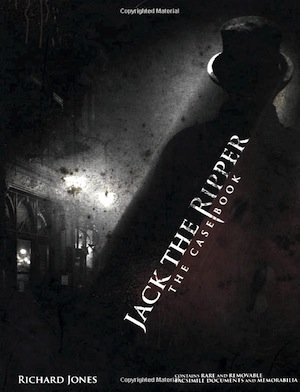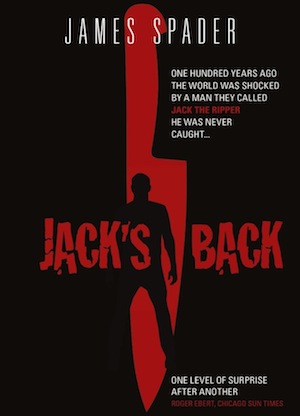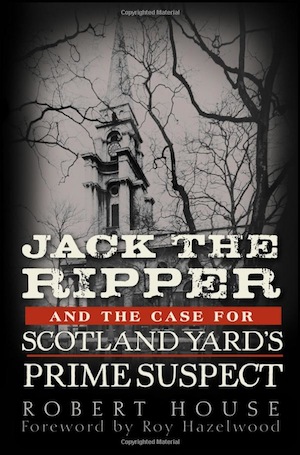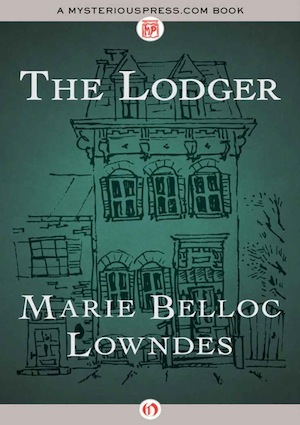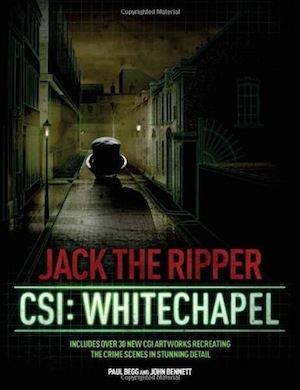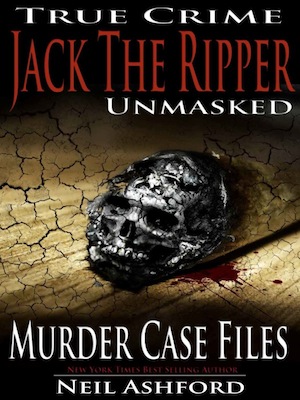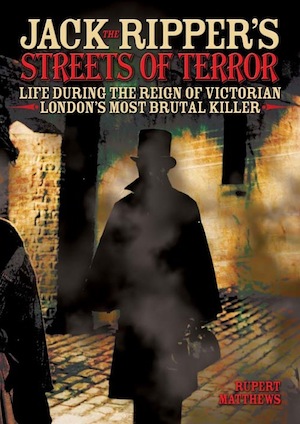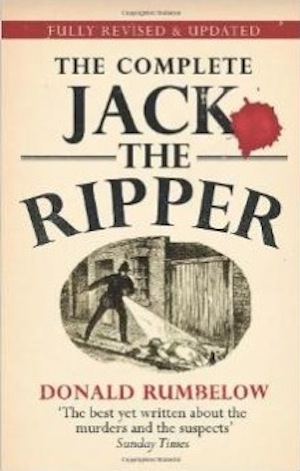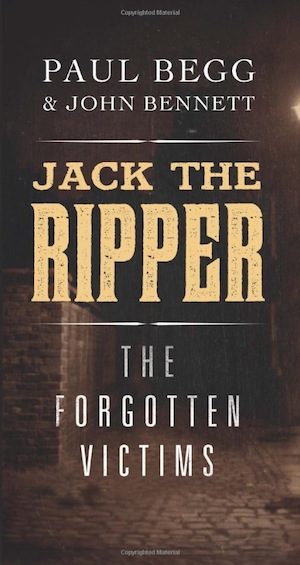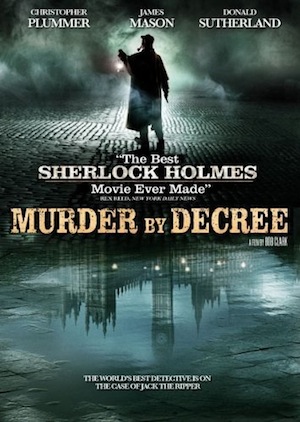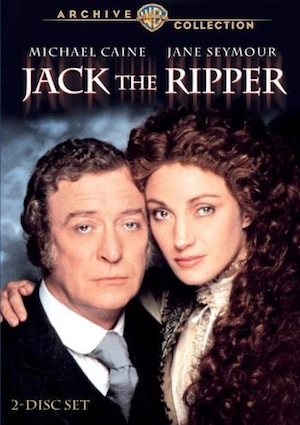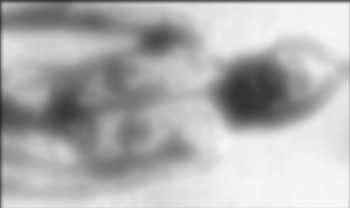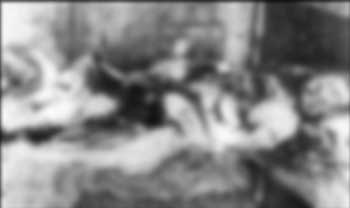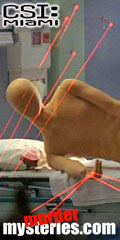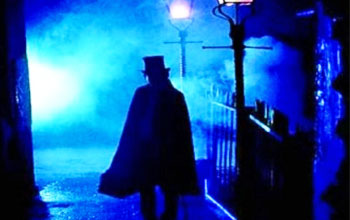
Jack the Ripper is the most well-known and enduring name given to the unknown and infamous serial killer who terrorized the poverty-stricken Whitechapel district of London in 1888. The name first appeared in an anonymous letter written by someone claiming to be the killer, which was quite probably a hoax, and could even have been the work of a reporter trying to stoke greater interest in the story.
The attacks made by the Ripper were savage from the beginning and grew more so over time. They were made against female prostitutes who lived and worked in the London slums. Typically the victims had their throats cut and their abdomens mutilated. Often internal organs were removed, which led to speculation that the perpetrator was a doctor or surgeon.
Several letters from one or more writers claiming to be the murderer were sent to newspapers and Scotland Yard. The "From Hell" letter, received by George Lusk of the Whitechapel Vigilance Committee, included half of a human kidney, supposedly taken from one of the victims. Because of the extremely brutal nature of the crimes, and because of the way the media covered them, the public came to believe that a single serial killer, "Jack the Ripper", was at large in Whitechapel.
Once established, legend of Jack the Ripper grew. It was and is an amorphous combination of legitimate research, folklore, and fabricated history. The term "ripperology" describes the study and analysis of the Ripper cases.
The Murders
There is much dispute as to how many of crime-ridden Whitechapel's murders can ultimately be tied to the Ripper, but a core group of five have come to be called the "canonical five" and are definitively believed to be his work.
Investigators have defined a gruesome cohort of crime scene elements that are hallmarks of the Ripper at work:
| • | Deep throat slashes |
|
| • | Abdominal and genital mutilation |
|
| • | Removal of internal organs |
|
| • | Progressive facial mutilation |
|
The canonical five Ripper victims are:
| • | Mary Ann Nichols |
|
| • | Annie Chapman |
|
| • | Elizabeth Stride |
|
| • | Catherine Eddowes |
|
| • | Mary Jane Kelly |
|
| Victim |
Notes |
|
| Mary Ann Nichols |
Mary's body was discovered around 3:40 AM on Friday, August 31, in Buck's Row. Her throat was severed by two cuts. The lower part of her abdomen was partly ripped open by a deep, jagged wound. Several other incisions on her abdomen were caused by the same knife. |
|
| Annie Chapman | Annie's body was discovered around 6 AM on Saturday, September 8, near a doorway in the back yard of 29 Hanbury Street, Spitalfields. As with Mary Ann Nichols, her throat was severed by two cuts. Her abdomen was slashed entirely open, and her uterus was removed. |
|
| Elizabeth Stride | Elizabeth was killed in the early morning of Sunday, September 30. Her body was found around 1:00 AM, in Dutfield's Yard, off Berner Street. She died from an incision that severed the main artery on the left side of her neck. There were no mutilations to her abdomen. |
|
| Catherine Eddowes | Like Elizabeth, Catherine was killed in the early morning of Sunday, September 30. Her body was found in Mitre Square, in the City of London, 45 minutes after Elizabeth's. Her throat was severed, and her abdomen was ripped open by a long, deep, jagged wound. Her left kidney and most of her uterus were removed. Part of a bloodied apron belonging to her was found at the entrance to a tenement on Goulston Street. |
|
| Mary Jane Kelly | Mary Jane's mutilated body was found lying on the bed in the single room where she lived at 13 Miller's Court, off Dorset Street, Spitalfields, at 10:45 AM on Friday, November 9. Her throat was severed down to her spine, and her abdomen was almost completely emptied of its organs. Her heart was missing. |
|
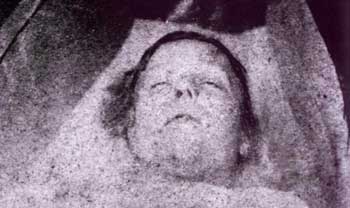
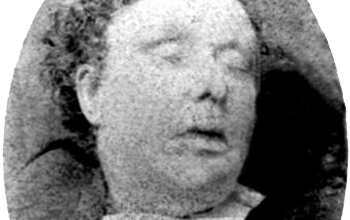
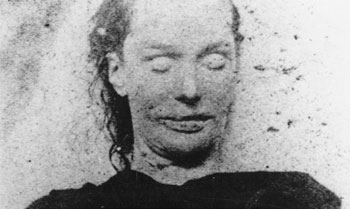
The canonical five murders were all committed at night, on or close to a weekend, either at the end of a month or a week or so later. The mutilations grew increasingly savage over time, except for that of Elizabeth Stride – most likely because her attacker was interrupted by a passer-by.
Mary Ann Nichols was not missing any organs.
Annie Chapman's uterus was taken.
Catherine Eddowes had her uterus and a kidney removed and her face mutilated.
Mary Jane Kelly's entire body was eviscerated and her face hacked away, though only her heart was actually missing from the crime scene.
The Investigation
A large force of investigators was mobilized for house-to-house inquiries throughout Whitechapel. Forensic material was collected and examined. Suspects were identified, traced and examined more closely when necessary. Over 2,000 people were interviewed – more than 300 of them received closer examination, and 80 of those ended up being detained for various periods of time.

Detective Inspector Edmund Reid headed the investigation. Soon he was joined by Inspectors Frederick Abberline, Henry Moore, and Walter Andrews from Scotland Yard. After the Eddowes murder, committed within the London city jurisdiction, investigators under Detective Inspector James McWilliam also joined the case.
Widespread dissatisfaction with the police spurred the formation of a private volunteer group in London's East End called the Whitechapel Vigilance Committee. It patrolled the streets in search of suspects, petitioned city officials to offer a reward for information about the killer, and hired private detectives.
Butchers, slaughterers, surgeons and physicians all fell under suspicion because of the Ripper's methods. The alibis of butchers and slaughterhouse workers were scrutinized (all were eventually cleared).
Queen Victoria, among many others, thought the pattern of attacks pointed to a butcher or cattle drover as the killer – riding as a passenger on one of the cattle boats that shuttled between London and the European mainland. Whitechapel was close to the London docks, and such boats generally docked on Thursdays or Fridays and left on Saturdays or Sundays. Investigators ruled the theory out after comparing the dates of the murders with cattle boat schedules.
Criminal profiling
At the end of October, Robert Anderson asked police surgeon Thomas Bond to assess the possible degree of the murderer's surgical skill. After examining the remains of Mary Jane Kelly and the post-mortem notes from the other canonical murders, Bond wrote:
All five murders no doubt were committed by the same hand. In the first four the throats appear to have been cut from left to right, in the last case owing to the extensive mutilation it is impossible to say in what direction the fatal cut was made, but arterial blood was found on the wall in splashes close to where the woman's head must have been lying.
All the circumstances surrounding the murders lead me to form the opinion that the women must have been lying down when murdered and in every case the throat was first cut.
Bond found no merit in the idea that the murderer had any scientific or anatomical knowledge, or even "the technical knowledge of a butcher or horse slaughterer." In his opinion the killer was a man of solitary habits, subject to periodic bouts of "homicidal and erotic mania," with the character of the mutilations possibly indicating "satyriasis". Bond further speculated that:
...the homicidal impulse may have developed from a revengeful or brooding condition of the mind, or that religious mania may have been the original disease but I do not think either hypothesis is likely.
Investigators found no evidence of sexual activity with any of the victims, but some psychologists believed that the penetration of the victims with a knife and the killer's preference for "leaving them on display in sexually degrading positions with the wounds exposed" was an indication that he found sexual pleasure in the attacks.
The Suspects
The concentration of the murders on weekends and holidays within a tight geographical area led many to speculate that the Ripper was a local resident and regularly employed. Others thought he was an educated member of the upper class, a doctor or an aristocrat, who slipped into and out of Whitechapel from an affluent part of town. With the passage of time, the list of suspects has swelled to include persons whose connection to the original case was remote at best, including many famous names who were never considered by police at the time.
The Letters
As the murders unfolded, police, newspapers and others found themselves besieged with letters about the case. Some were unsolicited if well-intentioned offers of advice for identifying the killer, but most were useless.
Hundreds of letters were written by people claiming to be the killer. Investigators eventually took only three of them seriously:
| • | The "Dear Boss" letter |
|
| • | The "Saucy Jacky" postcard |
|
| • | The "From Hell" letter |
|
The "Dear Boss" letter
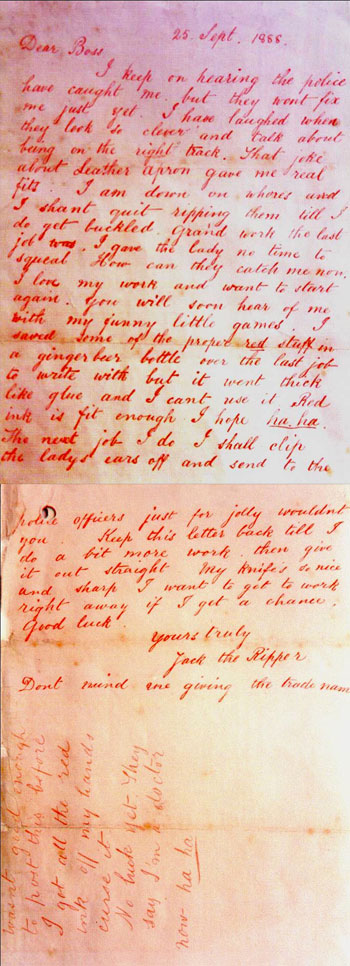
Dear Boss,
I keep on hearing the police have caught me but they wont fix me just yet. I have laughed when they look so clever and talk about being on the right track. That joke about Leather Apron gave me real fits. I am down on whores and I shant quit ripping them till I do get buckled. Grand work the last job was. I gave the lady no time to squeal. How can they catch me now. I love my work and want to start again. You will soon hear of me with my funny little games. I saved some of the proper red stuff in a ginger beer bottle over the last job to write with but it went thick like glue and I cant use it. Red ink is fit enough I hope ha. ha. The next job I do I shall clip the ladys ears off and send to the police officers just for jolly wouldn't you. Keep this letter back till I do a bit more work, then give it out straight. My knife's so nice and sharp I want to get to work right away if I get a chance. Good Luck. Yours truly
Jack the Ripper
Dont mind me giving the trade name
PS Wasnt good enough to post this before I got all the red ink off my hands curse it No luck yet. They say I'm a doctor now. ha ha
The "Dear Boss" letter was dated September 25th. It was postmarked and received by the Central News Agency on the 27th. They forwarded it to Scotland Yard two days later. Initially dismissed as a hoax, investigators took it more seriously when the body of Catherine Eddowes was found on September 30th with one ear partially cut off. The letter contained the first known appearance of the name "Jack the Ripper" and quickly achieved universal notoriety.
The "Saucy Jacky" postcard
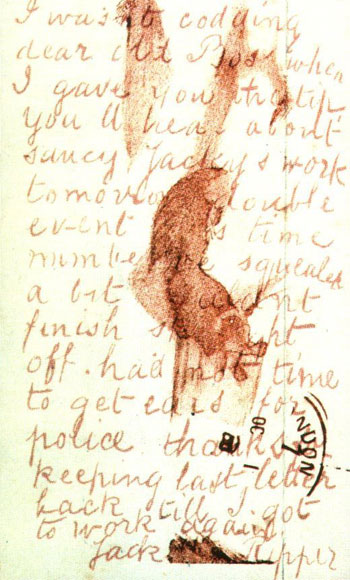
I was not codding dear old Boss when I gave you the tip, you'll hear about Saucy Jacky's work tomorrow double event this time number one squealed a bit couldn't finish straight off. ha not the time to get ears for police. thanks for keeping last letter back till I got to work again.
Jack the Ripper
The "Saucy Jacky" postcard was postmarked and received by the Central News Agency on October 1st, 1888. The handwriting was strikingly similar to the "Dear Boss" letter. In mentioning the killing of two victims in close proximity to each other – "double event this time" – it refers to the murders of Elizabeth Stride and Catherine Eddowes. Because it was postmarked more than 24 hours after the killings occurred and were known to journalists and local residents, it could be a hoax.
The "From Hell" letter
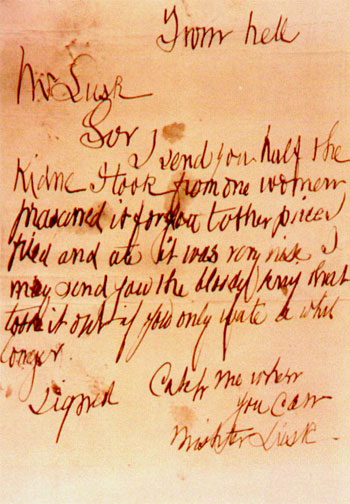
From hell.
Mr Lusk,
Sor
I send you half the Kidne I took from one woman and prasarved it for you tother piece I fried and ate it was very nise. I may send you the bloody knif that took it out if you only wate a whil longer
signed
Catch me when you can
Mishter Lusk
The "From Hell" letter was addressed to George Lusk, leader of the Whitechapel Vigilance Committee, on October 16th. Its handwriting and style are quite different from the "Dear Boss" and "Saucy Jacky" missives. The letter was accompanied by a small box containing half of a kidney, which was preserved in ethanol (Eddowes' left kidney had been taken by the killer). The writer claimed that he "fried and ate" the missing half. The kidney was examined by Dr. Thomas Openshaw of London Hospital, who determined that it was human and came from the left side.
Scotland Yard published facsimiles of the "Dear Boss" letter and "Saucy Jacky" postcard, hoping someone would recognise their handwriting and step forward, but no-one did. Police officials later claimed they had identified a particular journalist, Tom Bullen, as the author of both the "Dear Boss" letter and the postcard. Another journalist, Fred Best, confessed decades later that he'd written the letters to "keep the business alive".
The Media
The Ripper murders were a turning point in the coverage of crime by journalists. Though he was far from being the first serial killer, Jack the Ripper was the first to become the focus of a global media frenzy. Victorian-era print media included mass-circulation newspapers that sold for as little as a halfpenny. These, along with magazines such as The Illustrated Police News, were instrumental in turning the Ripper into a publicity phenomenon.
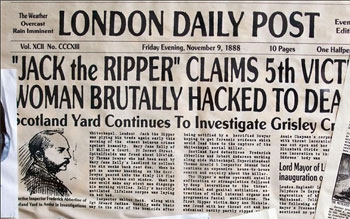
After the publication of the "Dear Boss" letter, the coining of a nickname for a killer became standard media practice. Later derivations of Jack the Ripper's name would include the French Ripper, the Düsseldorf Ripper, the Blackout Ripper, the Camden Ripper, the Yorkshire Ripper, and the Rostov Ripper.
Historical Impact
The spectacle of the murders and the victims shocked the conscience of British society and led to political and social movements that improved living conditions in the East End. Over a twenty-year period following the murders, the worst of the slums were razed, but the streets and some buildings still survive and the legend of the Ripper is promoted. The original murder sites are tourist attractions.
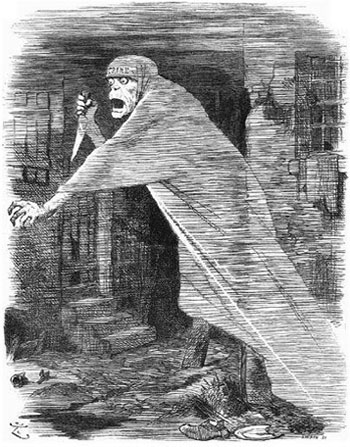
Since the murders, Jack the Ripper has become a universal bogey man for children. Depictions of him have changed over the years. Early portrayals were often spectral or monstrous. In the 1920s and '30s, films showed him clothed in everyday dress as a man preying on unknowing victims, his menace conveyed with lighting and atmospheric effects. By the 1960s, the Ripper was transformed into a symbol of a "predatory aristocracy" who was often dressed as a gentleman in a top hat.
The scarcity of surviving forensic evidence has impeded present-day efforts to identify him. DNA analysis of existing letters has been inconclusive. The available evidence has been handled so often and has been so thoroughly compromised by contamination that trustworthy results will probably never come from it.
Jack the Ripper has been the subject of hundreds of works of fiction and non-fiction. He has appeared in novels, short stories, poems, comic books, games, songs, plays, operas, television, and film. His crimes have been the exclusive subject of more than 100 works of non-fiction, making him among the most written-about true-crime figures. The term "ripperology" was coined by Colin Wilson in the 1970s to describe the study of his case by professionals and amateurs.
Because of their policy of not modelling persons whose physical appearance is not known, there is no waxwork figure of Jack the Ripper on display at Madame Tussauds' Chamber of Horrors. He is depicted as a shadow.

